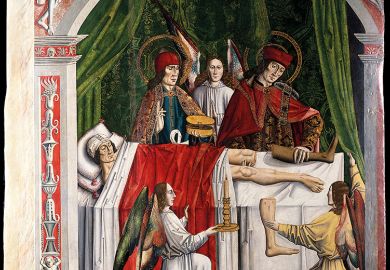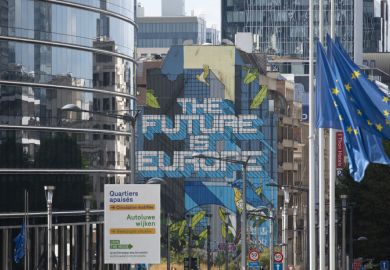In academia, as everybody knows, it’s publish or perish. But it turns out that it’s also publish and perish: publishing, at least in my field of art history, leads to poverty. I am a full professor, fully employed, but I am contemplating getting a second job to support myself and my research. Paradoxically, the more successful I am, the poorer I get.
Here I want to address a few major systemic issues that art historians encounter. Although writing illustrated publications is widely acknowledged to be a key part of our job, and required by hiring and promotions committees, our universities do not adequately support these activities. In fact, universities expect us to absorb enormous costs.
I write about late medieval culture, manuscripts and their original functions, the structure and stratigraphy of manuscripts assembled over time, experimental shifts from manuscript to print, and forensic methods of detecting historical use of books. During my time at St Andrews, I have published six monographs, incorporating 1,215 images in all, and a seventh will appear in 2020 or 2021. I have also published 14 articles, which represent another 120 images, plus one article that had 84 images alone. I have therefore used a total of 1,419 images in books and articles that either can be or have been submitted to the research excellence framework by the university.
For the kind of work I do, it would be impossible to publish the ideas without having the images. The images form a dataset, a kind of proof that allows the reader to verify that what I am saying is true.
Yet writing and publishing my books has cost me everything I have. Here’s a breakdown of the eight kinds of costs involved in researching, illustrating and publishing them:
- Travelling to collections to undertake original research on medieval manuscripts. Only a fraction of the world’s manuscripts have been digitised and put online. In any event, the kind of research I do, involving use-wear analysis and structural interrogation, requires looking at the objects first-hand. I take dozens of flights and train journeys every year to visit collections and study them.
For Rubrics, Images and Indulgences in Late Medieval Netherlandish Manuscripts (2017), I took over 550 trips to 163 individual repositories of medieval manuscripts. For my other projects, I did not count individual trips. Some libraries I visited many times. For example, I made more than 200 trips to the Royal Library in Brussels over a 12-year period. (Those between 2003 and 2006 were funded by the Dutch government, but the rest were self-funded.) - Buying study photographs. In the past, scholars would buy microfilms that contained, usually in black and white, a shot of each folio or opening. This technology is largely outdated, and it is hard to find a microfilm reader. Hand-held photos that I take with my own digital camera are vastly superior, because I can shoot details such as gutters with stubs indicating missing folios, backlighted folios that reveal where something was sewn in or folios in raking light that reveal surface contours.
Many collections allow researchers to use their phones or cameras to take study-quality photos of their manuscripts, although some libraries extract money for the right to photograph. For example, in the diocesan library in Wrocław (Breslau, Poland), I had to pay a large fee, in cash, to the priest in charge of the collection, for the privilege of using a camera.
Even worse, many collections such as the Fitzwilliam Museum, the British Library and the Zentralbibliothek in Zurich do not allow photography of their illuminated manuscripts at all. If a manuscript has not been digitally catalogued on their web pages, the researcher must pay for professionally made images in order to have a record for study. Currently, at the British Library, medium-resolution images cost £29.95 for the first image, and £8 for each subsequent image from the same manuscript. At the Fitzwilliam, new photography costs £35, and obtaining existing high-resolution images £40 per shot. The cost of buying study images from these collections is holding back my research.
One manuscript at the British Library that I needed to have digitised was a prayer roll 11 metres long. After making two self-funded trips from Scotland to London to see it – trips costing about £450 each when you add up the train, hotel and restaurants – I decided that commissioning photography was the only way I could adequately study the roll, its components and their stratigraphy. I paid £314.34 to have the manuscript digitised. Immediately afterwards, the British Library put the images I had commissioned on its website for everyone to use. Although I want the public to have access to this magnificent and odd manuscript, is it really my job to subsidise access out of my own pocket? - Paying registration, accommodation and travel fees to share research at conferences. In my field of medieval studies, there are two main annual conferences, one in Leeds (England) and one in Kalamazoo, Michigan (US). Presenting research in public forums such as these is an essential part of the process of idea formation. Audience members ask questions that help to shape the research, and giving public presentations helps to sharpen a researcher’s arguments. Between the transportation, accommodation, food and registration fees, attending these events costs between £750 and £2,300. (The School of Art History gives us an annual research budget of £1,200. This is supposed to cover undertaking research and attending conferences. In fact, I spend that amount on research every month.)
- Buying high-resolution images for publication. Publishers demand 300 dpi digital images for publication. The directorate at the Royal Library in The Hague believes that the public already owns the collection items and should not have to pay for them twice. Yet other institutions charge enormous fees for high-res images, such as Stockholm’s Royal Library, where a single image costs SKr1,500 (£143.80). I received a recent order from the Bodleian Library in Oxford for images totalling £4,753.38 for my next book, about deliberate and inadvertent damage in manuscripts. Because the work usually involves showing the damage in its context, most of the order consists of two-page spreads. The shots cost £17.20 apiece, and the library insists that each side of the opening must be photographed separately.
Of the 1,419 images I have published since 2011, I was given 70 by my former professor, James Marrow, and 20 were provided free by curators (largely from German, Dutch and French libraries). About 366 came from the Royal Library in The Netherlands, where the images cost only €5 apiece. But that leaves around 963 that I paid for myself, at a conservatively estimated average cost of £25 per image, totalling more than £24,000 out of pocket. (If I’d had to pay at the rate charged by the Swedish Royal Library, my bill for high-resolution images alone would have been £204,052.20.) - Paying for data storage. I keep the thumbnails of some 750,000 images on my local machine to have constant access to them. They are the records of all I have seen and the drivers behind all of my publications. The full-size “mother images” I keep on a sprawling series of 8-terabyte hard drives, with a back-up in the cloud. The university pays for my hardware and software, but I pay about £1,000 per year for cloud storage out of my own pocket.
- Paying copyright fees. Many institutions, especially those in the UK, demand a fee for allowing scholars to publish their images in books and articles, even those for scholarly audiences. For my recent book, Image, Knife, and Gluepot: Early Assemblage in Manuscript and Print (2019), published as a free, open-access book, the British Library charged me £15 per image from its collection, of which there were 56, for a total of £840 (reduced after a pleading letter to £504). Likewise, I received an invoice from the Bodleian for £4,736 plus 20 per cent VAT (£5,683) for the reproduction costs of my next book, Touching Skin: How Medieval Users Rubbed, Touched, and Kissed Their Manuscripts.
- Providing free copies of books. Scholars are obligated to supply free copies of their books to the libraries that provided images (as well as for the REF). In Postcards on Parchment: The Social Life of Medieval Books (2015), I published images from 70 different libraries and also gave copies to individuals who had offered help and information. For all these giveaways, the publisher provided five free copies, so I had to buy another 75 from my own pocket, totalling £1,675, to fulfil the contractual obligations.
- Paying for production fees. Publishers often extract fees from authors. But this is not vanity publishing. This is fully peer-reviewed, bona fide academic publishing. When I submitted a complete book manuscript to a Canadian university press in 2015, the editor demanded proof that I could supply a C$48,000 (£30,000) production fee before he would send it out to reviewers. Brill received €8,750 (£8,000) for producing Rubrics, Images and Indulgences (2017), which a private donor kindly paid for me. Open Book asks £3,500 for each title it publishes. (There are three or four funds that help to subsidise production fees. Competition for them is fierce, and they usually pay between $500 and $1,000.)

As a result of all these costs, the more I publish, the poorer I am. After working at St Andrews for eight years, I own no property. I have no savings. My pension will be minuscule. Yet I have had to plough most of my disposable income back into research activities that have helped make the university shine. (The Principal’s Office asked me to supply a copy of Postcards on Parchment, as a showpiece or gift for a visitor.)
So what needs to be done? If universities actually desire (and reward with promotion) research in the humanities, they need to bring funding into line with costs. US institutions give their professors much more research funding. If we are to keep pace with them on a world stage, then we need more access to resources. I have expressed my willingness for years to work with development to raise money for these activities.
Image-holding institutions should rethink their purpose. They can never have enough in-house expertise to fully research all of their holdings. They should be grateful to scholars who are applying their expertise to their collections. The least they can do is to make images available for free. They should also allow researchers to make study photographs and produce high-resolution images for publication at low costs.
Digital publishing is simply the most efficient and cost-effective way to get ideas out into the world. We need to fully legitimate digital, online, peer-reviewed publishing and make it the norm. We need to create a world where young people will publish online, without fearing that it will harm their careers.
It sometimes seems to me that academic success is designed for people who are already wealthy, just as first-class seating in airplanes is designed for tall men. Underfunded humanities are an extension of unpaid internships and poorly paid fellowships in museums. Do we really believe that our disciplines are just a decoration and offer viable careers only to those with trust funds?
Kathryn M. Rudy is professor of art history at the University of St Andrews. Her most recent book is Image, Knife, and Gluepot: Early Assemblage in Manuscript and Print (2019).
POSTSCRIPT:
Print headline: Publish and perish
Register to continue
Why register?
- Registration is free and only takes a moment
- Once registered, you can read 3 articles a month
- Sign up for our newsletter
Subscribe
Or subscribe for unlimited access to:
- Unlimited access to news, views, insights & reviews
- Digital editions
- Digital access to THE’s university and college rankings analysis
Already registered or a current subscriber? Login








